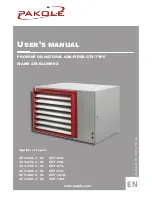
17
Battery Failures
Some common causes for battery failure are: incorrect
initial activation, lack of water, adding chemicals other
than water after initial activation, undercharging,
overcharging, corroded connections, freezing. These
failures do not constitute warranty.
Lubrication
WARNING: Always stop engine and
disconnect spark plug wire before
cleaning, lubricating or doing any kind of
work on lawn tractor.
Pivot Points
•
Lubricate all pivot points with light oil once a season.
Ball Joints
•
The ball joints and drag link ends are permanently
lubricated and do not need periodic lubrication.
Hydrostatic Transmission
The hydrostatic transmission is filled at the factory and
does not require checking. If repairs are needed,
contact your local service dealer. (Hydrostatic
transmission contains approximately 2.5 quarts of SAE
20W50 oil.)
Figure 17
Steering Gears
•
Lubricate teeth of steering gears with automotive
multi-purpose grease after every 25 hours of
operation or once a season. See Figure 17 .
Steering Shaft
•
Lubricate steering shaft at least once a season with
light oil. See Figure 17 .
Linkage
•
Once a season lubricate all the pivot points on the
clutch, brake and lift linkage with SAE 30 engine oil.
See Figure 17 .
Wheels
•
The front wheels may be provided with optional
grease fittings. The rear wheels must be removed
from the axle for lubrication. Lubricate at least once
a season with automotive multi-purpose grease.
Cutting Blades
Removing Blade
WARNING: Be sure to disconnect and
ground the spark plug wire(s) and remove
ignition key before working on the cutting
blade to prevent accidental engine
starting. Protect hands by using heavy
gloves or a rag to grasp the cutting blades.
•
Remove the hex flange nut which holds the blade to
the blade spindle.
See Figure 18.
•
Remove the blade from the spindle.
Figure 18
Sharpening Blade
•
Remove the cutting blades by following the
directions in the preceding section.
•
When sharpening the blades, follow the original
angle of grind as a guide. It is extremely important
that each cutting edge receives an equal amount of
grinding to prevent an unbalanced blade. An
unbalanced blade will cause excessive vibration
when rotating at high speeds, may damage the
tractor and/or could break, causing personal injury.
Balancing Blade
•
The blade can be tested for balance by balancing it
on a round shaft screwdriver. Remove metal from
the heavy side until it balances evenly.
Reassembly
•
When replacing blades, be sure to install the blade
with the side of the blade marked ‘‘Bottom’’ (or with
Lube
Lube
Lube
Blade
Hex Flange
Nut
Deck
Blade
Содержание 699 Series
Страница 23: ...23 Your Notes Date Comments ...








































